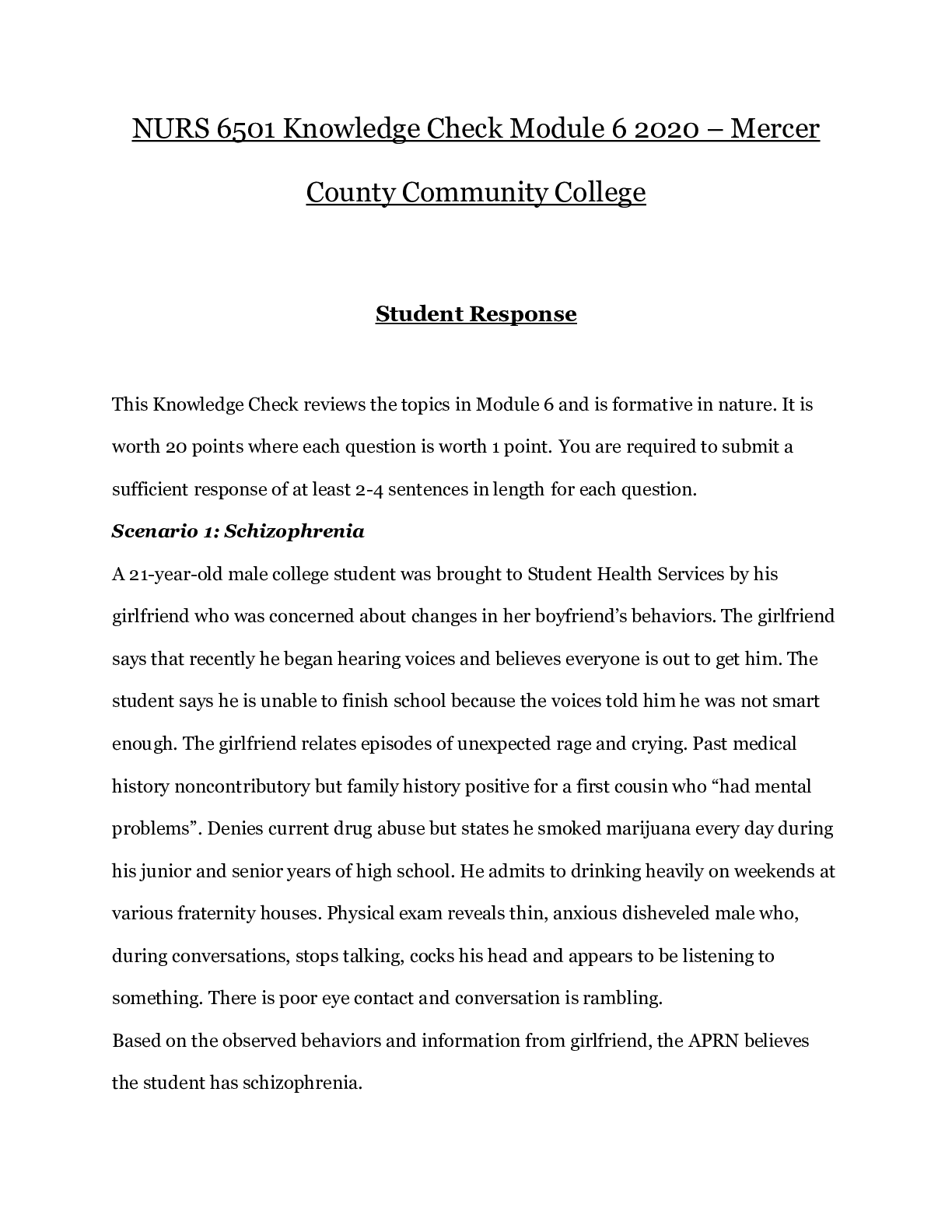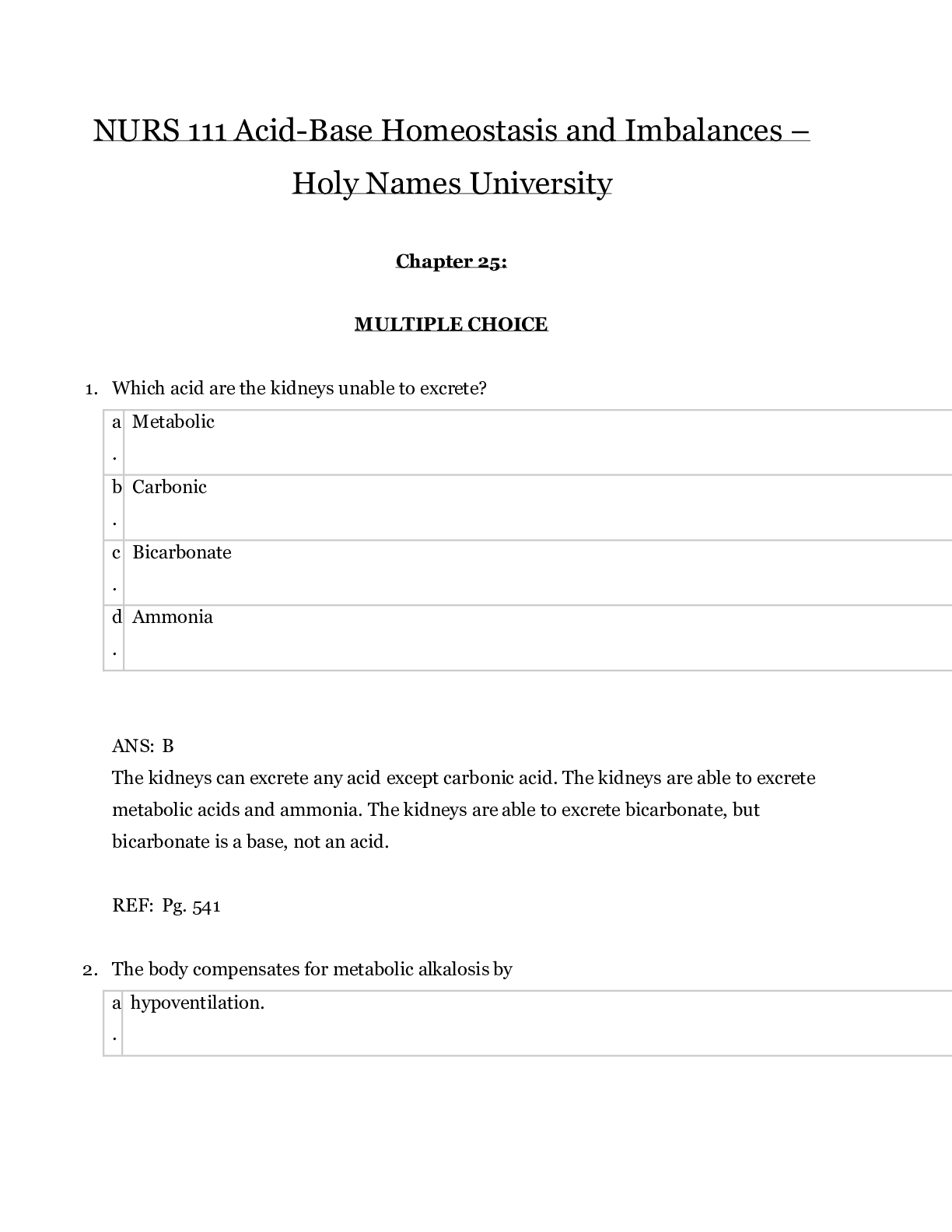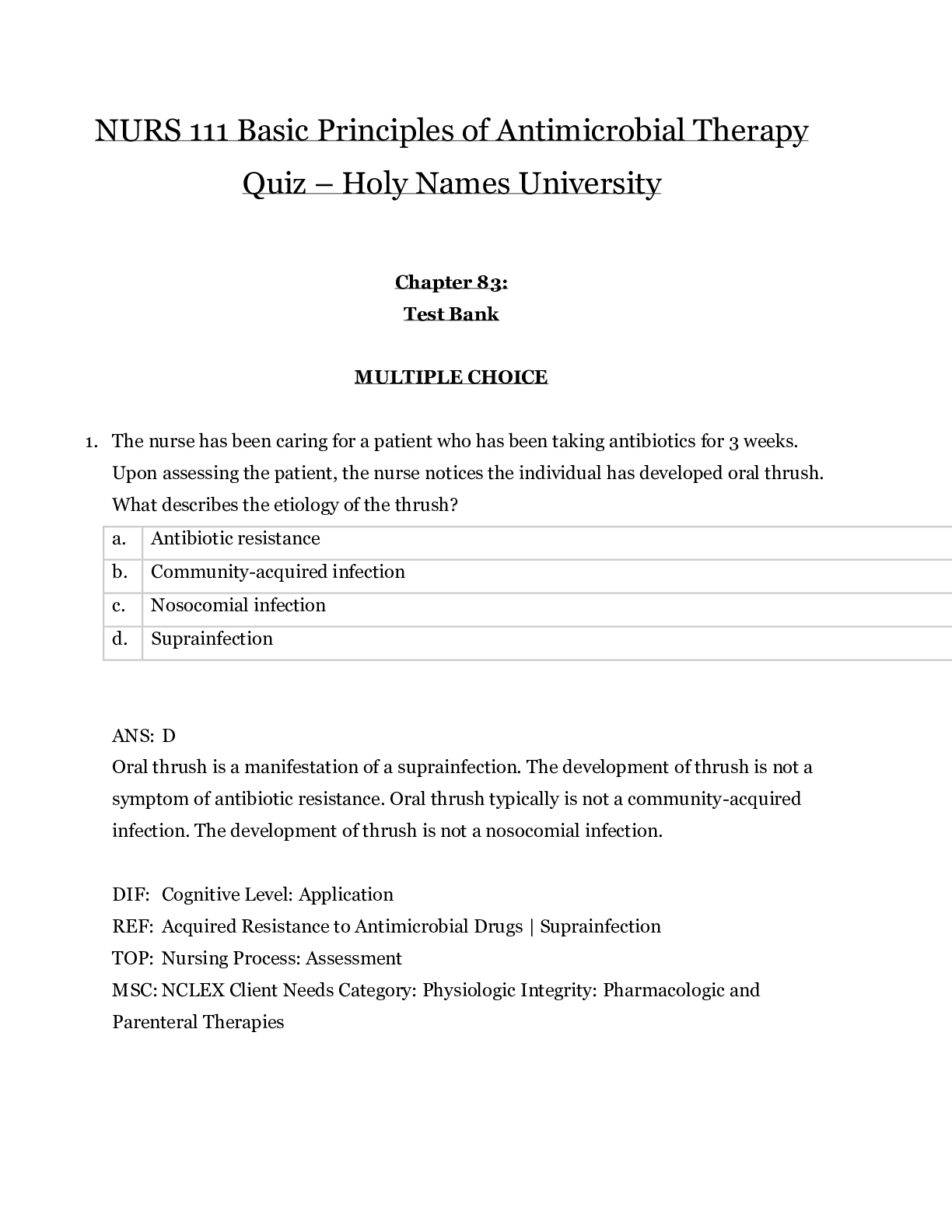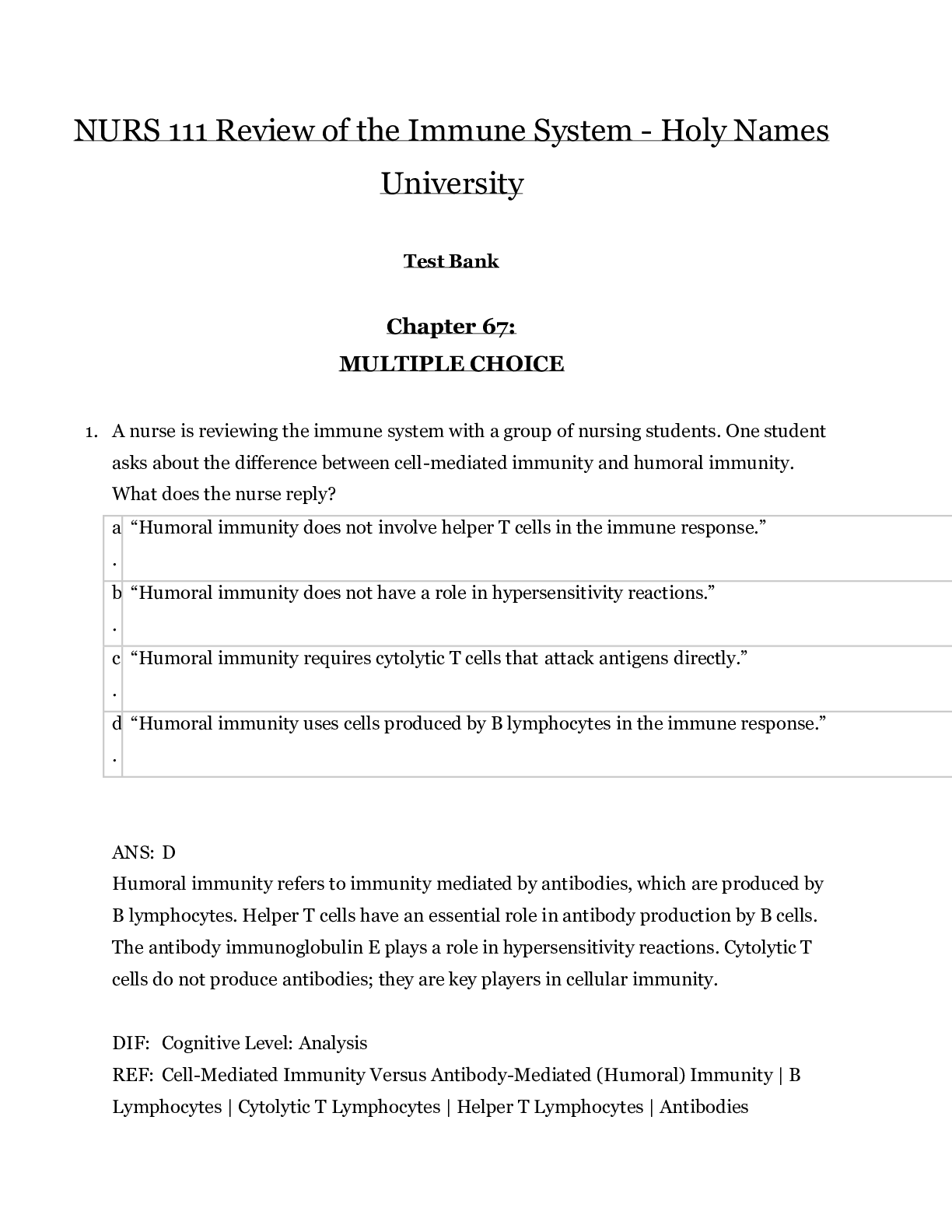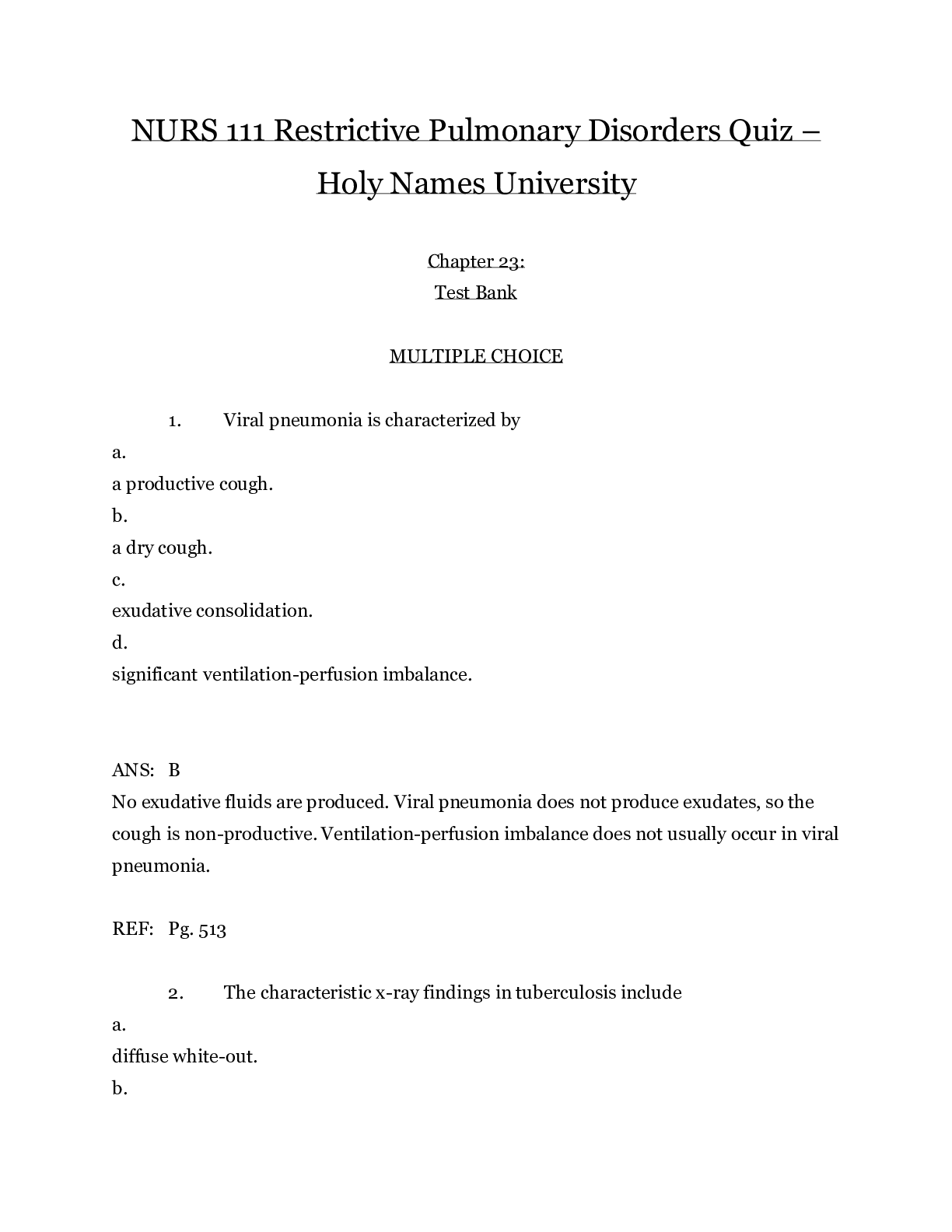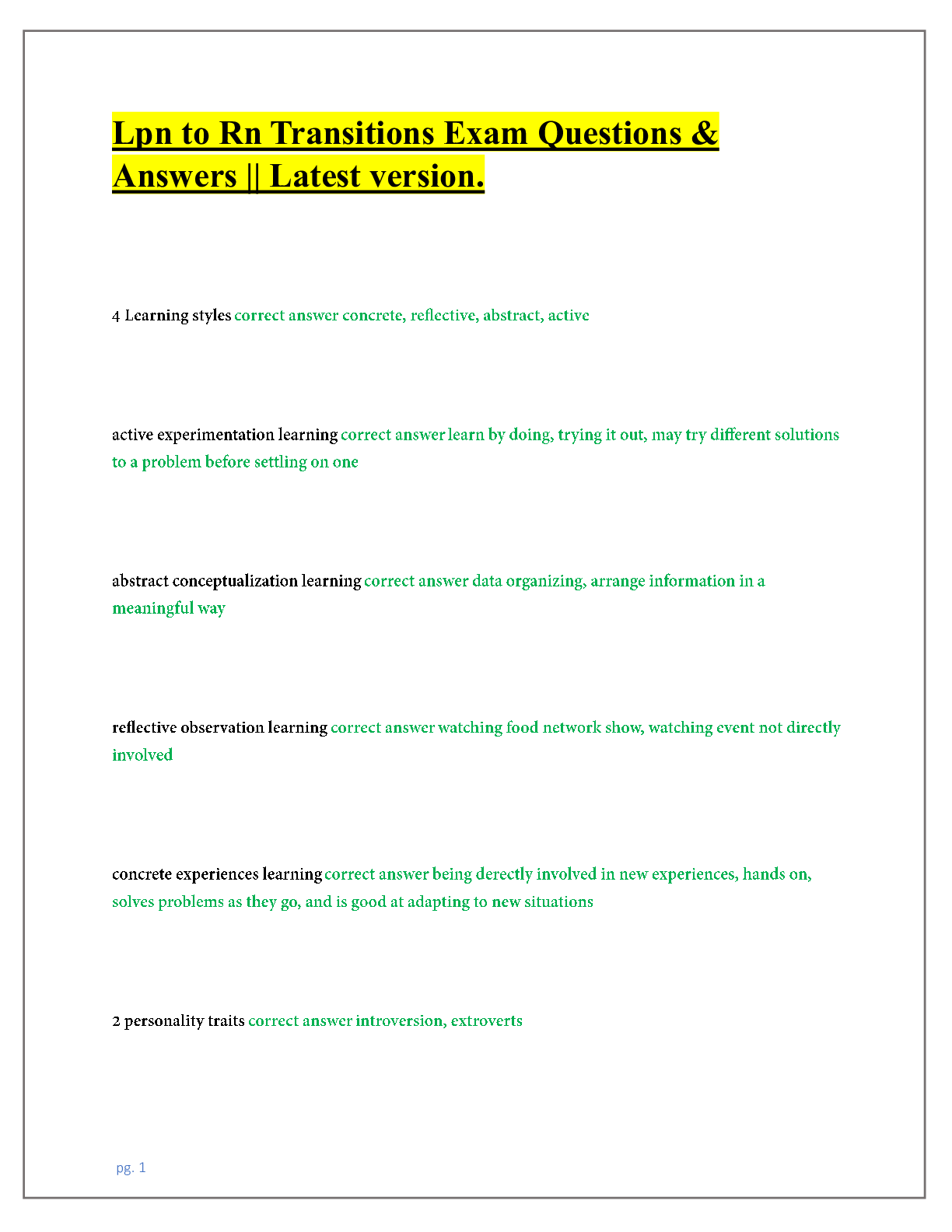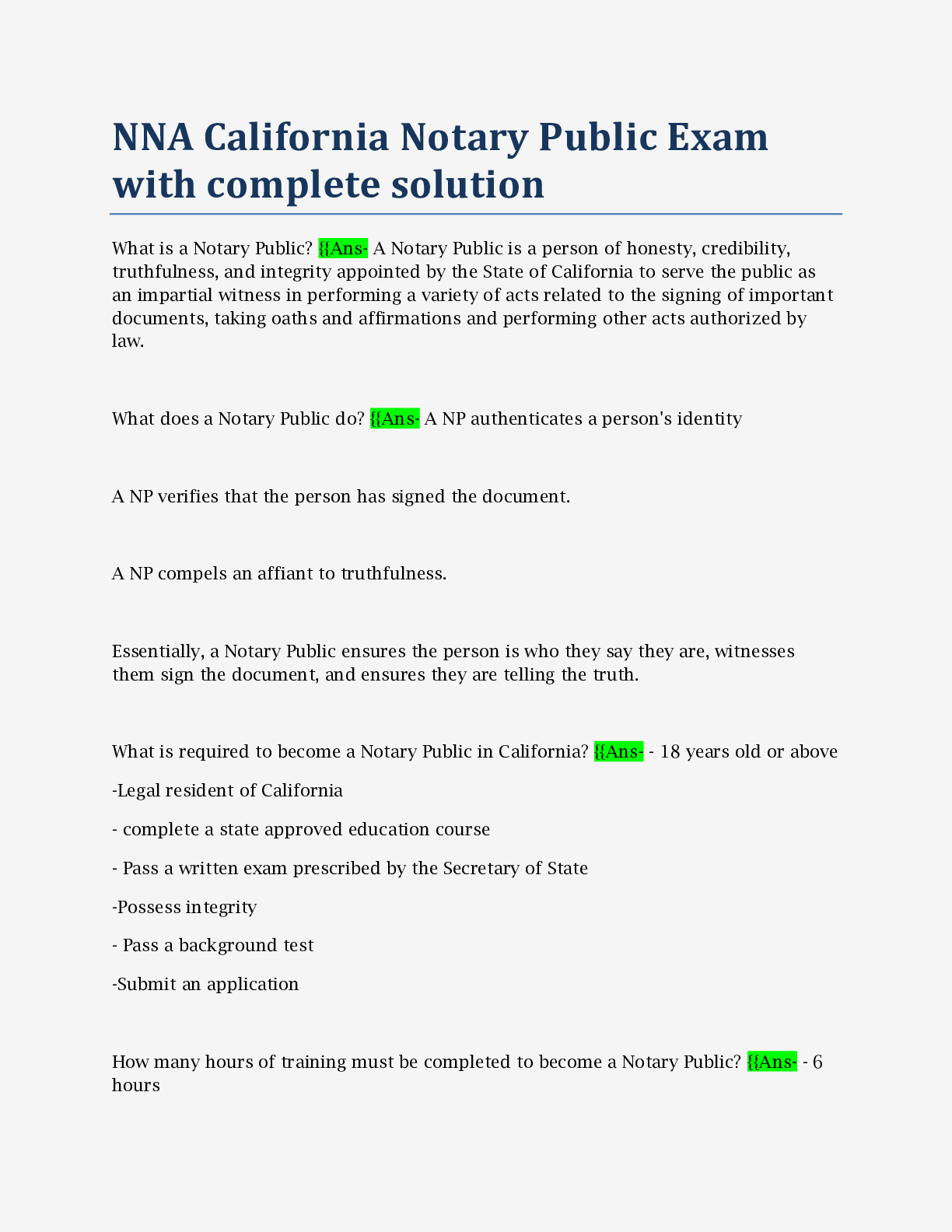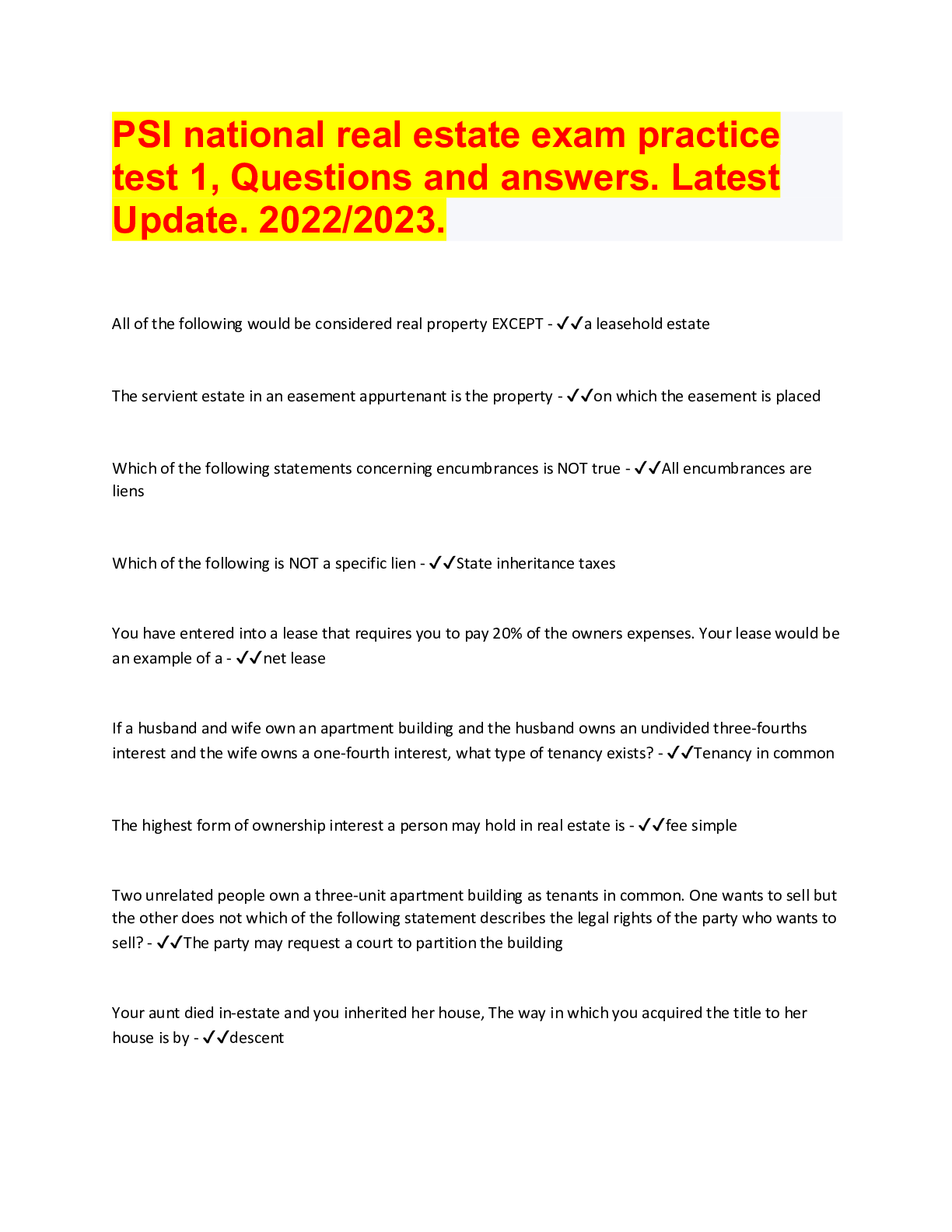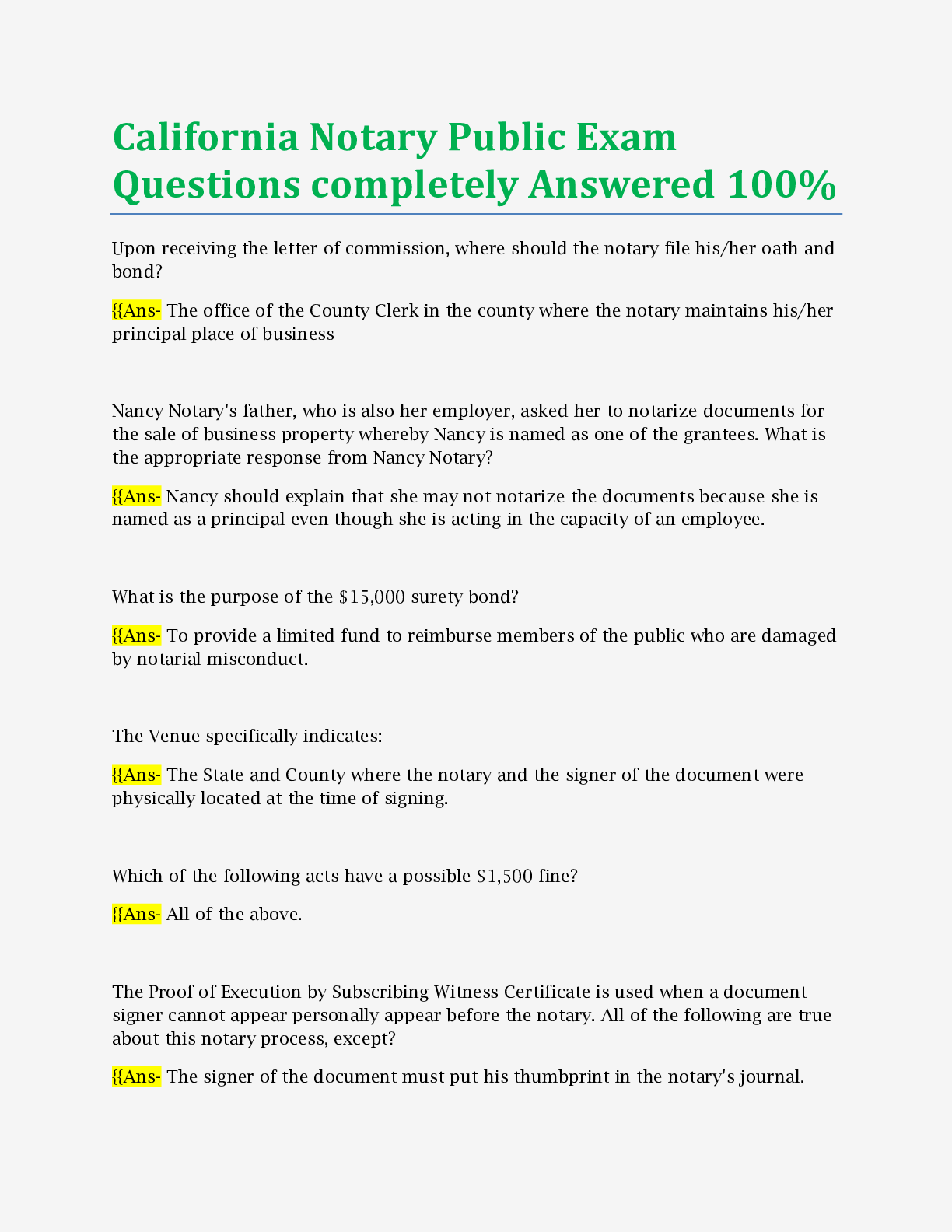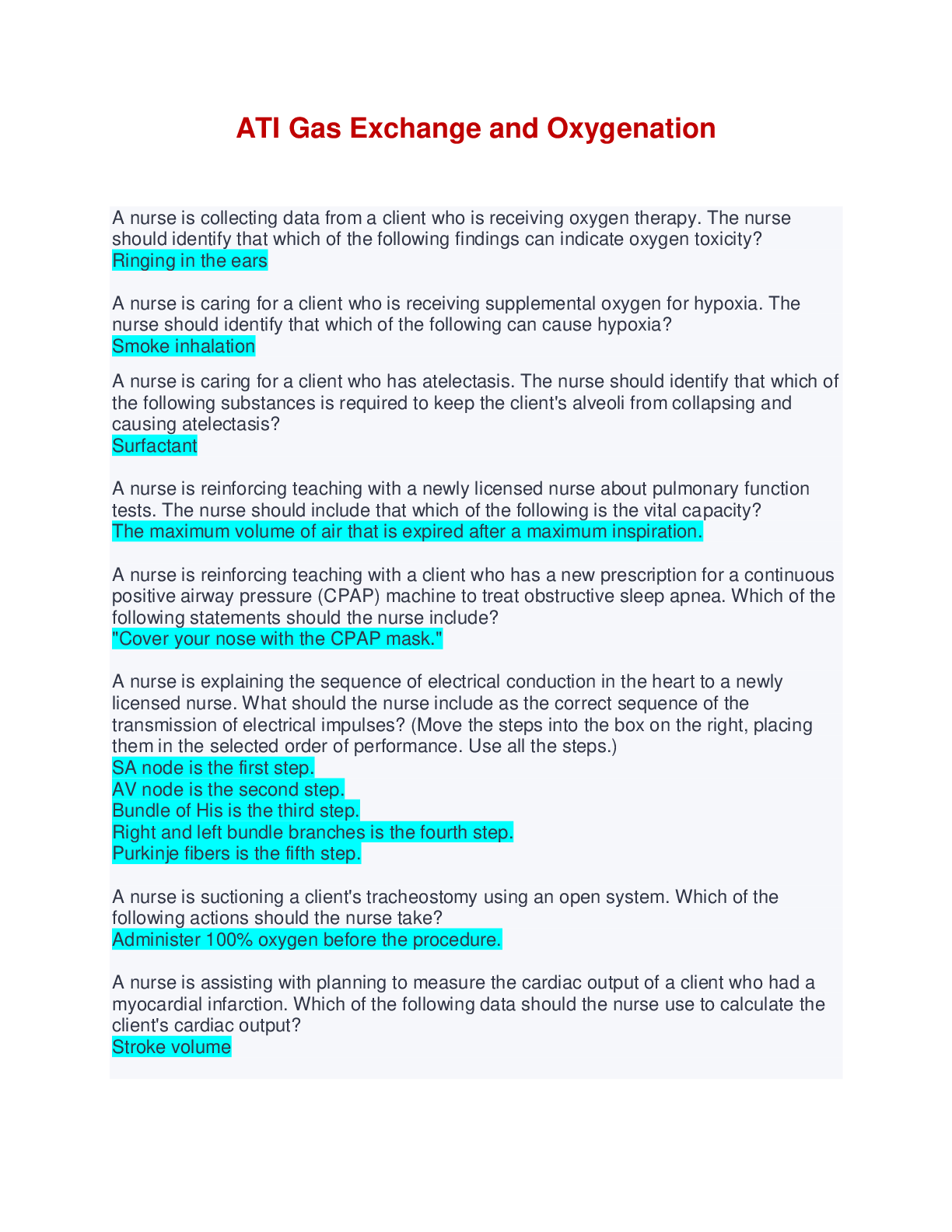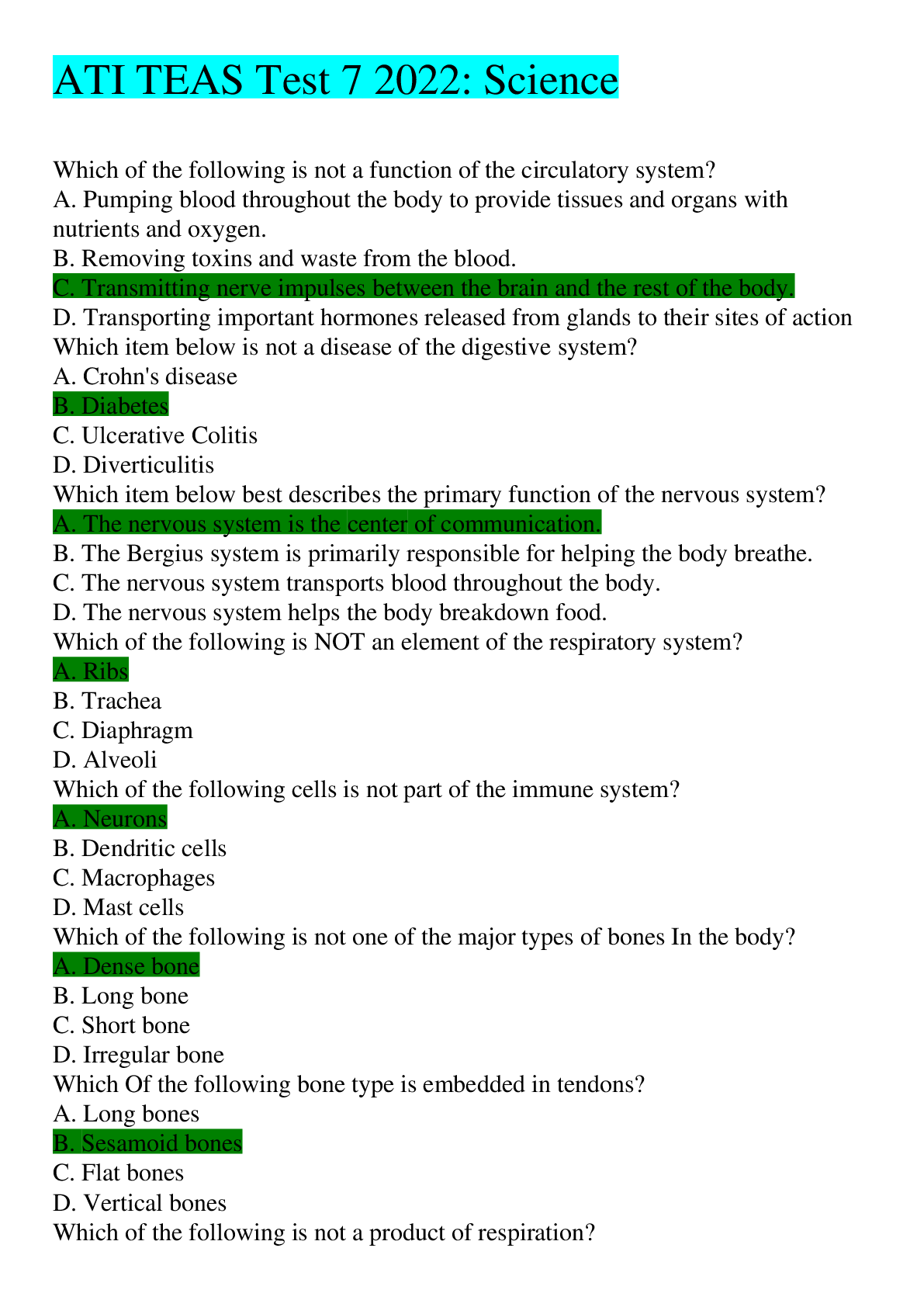*NURSING > EXAM > NURS 111 Drugs for Asthma Quiz – Holy Names University | NURS111 Drugs for Asthma Quiz (All)
NURS 111 Drugs for Asthma Quiz – Holy Names University | NURS111 Drugs for Asthma Quiz
Document Content and Description Below
NURS 111 Drugs for Asthma Quiz – Holy Names University Chapter 76: Test Bank MULTIPLE CHOICE 1. A patient with asthma will be using a metered-dose inhaler (MDI) for delivery of an inhaled... medication. The provider has ordered 2 puffs to be given twice daily. It is important for the nurse to teach this patient that: a. a chlorofluorocarbon (CFC) propellant is superior to a hydrofluoroalkane (HFA) propellant. b. the patient should activate the device and then inhale. c. the patient should store the MDI in the refrigerator between doses. d. the patient should wait 1 minute between puffs. 2. A patient newly diagnosed with asthma receives prescriptions for an inhaled glucocorticoid and an inhaled beta2-adrenergic agonist. Which statement by the patient indicates understanding of this medication regimen? a. “I should use the glucocorticoid as needed when symptoms flare.” b. “I will need to use the beta2-adrenergic agonist drug daily.” c. “The beta2-adrenergic agonist suppresses the synthesis of inflammatory mediators.” d. “The glucocorticoid is used as prophylaxis to prevent exacerbations.” 3. A patient who uses an inhaled glucocorticoid for chronic asthma calls the nurse to report hoarseness. What will the nurse do? a. Ask whether the patient is gargling after each dose of the glucocorticoid. b. Request an order for an antifungal medication. c. Suggest that the patient be tested for a bronchial infection. d. Tell the patient to discontinue use of the glucocorticoid. 4. A patient with asthma is admitted to an emergency department with a respiratory rate of 22 breaths per minute, a prolonged expiratory phase, tight wheezes, and an oxygen saturation of 90% on room air. The patient reports using fluticasone (Flovent HFA) 110 mcg twice daily and has used 2 puffs of albuterol (Proventil HFA), 90 mcg/puff, every 4 hours for 2 days. The nurse will expect to administer which drug? a. Four puffs of albuterol, oxygen, and intravenous theophylline b. Intramuscular glucocorticoids and salmeterol by metered-dose inhaler c. Intravenous glucocorticoids, nebulized albuterol and ipratropium, and oxygen d. Intravenous theophylline, oxygen, and fluticasone (Flovent HFA) 220 mcg 5. A parent asks a nurse about growth suppression resulting from the use of an inhaled glucocorticoid in children. What will the nurse tell the parent? a. Growth may be slowed, but eventual adult height will not be reduced. b. The growth rate is not impaired, but overall height will be reduced. c. The growth rate slows while the drug is used but resumes when the drug is stopped. d. Long-term use of the drug results in a decrease in adult height. 6. A young adult woman will begin using an inhaled glucocorticoid to treat asthma. The nurse will teach this patient about the importance of which action? a. Lowering her calcium intake and increasing her vitamin D intake b. Participating in weight-bearing exercises on a regular basis c. Taking oral glucocorticoids during times of acute stress d. Using two reliable forms of birth control to prevent pregnancy 7. A 7-year-old child with asthma uses a daily inhaled glucocorticoid and an albuterol MDI as needed. The provider has added montelukast (Singulair) to the child’s regimen. Which statement by the child’s parent indicates understanding of this medication? a. “I may notice mood changes in my child.” b. “I should give this medication twice daily.” c. “I will give my child one 4-mg chewable tablet daily.” d. “This drug can alleviate symptoms during an acute attack.” 8. A nurse is teaching a group of nursing students about the different formulations of beta2-adrenergic agonist medications. Which statement by a student indicates understanding of the teaching? a. “Beta2-adrenergic agonists provide quick relief via any formulation.” b. “Long-acting beta2 agonists may be used alone to prevent attacks.” c. “Short-acting beta2 agonists are usually given by nebulizer.” d. “Oral beta2 agonists are not useful for short-term treatment.” 9. A patient with asthma comes to a clinic for treatment of an asthma exacerbation. The patient uses an inhaled glucocorticoid, montelukast (Singulair), and a SABA via MDI. The nurse assesses the patient and notes a respiratory rate of 18 breaths per minute, a heart rate of 96 beats per minute, and an oxygen saturation of 95%. The nurse auscultates mild expiratory wheezes and equal breath sounds bilaterally. What will the nurse do? a. Contact the provider to request a systemic glucocorticoid. b. Contact the provider to suggest using a long-acting beta2 agonist. c. Evaluate the need for teaching about MDI use. d. Question the patient about how much albuterol has been used. 10. A patient who takes theophylline (Theochron) twice daily for chronic stable asthma develops an infection and will take ciprofloxacin. The nurse will contact the provider to discuss: a. changing to a different antibiotic. b. reducing the theophylline dose. c. giving theophylline once daily. d. switching from theophylline to a LABA. 11. A nurse and a nursing student are reviewing the care of a 30-kg patient who will receive intravenous aminophylline. Which statement by the student indicates an understanding of the administration of this medication? a. “After the loading dose has been given, the patient will receive 6 mg/kg/hr.” b. “Dosing is titrated based on the serum theophylline levels.” c. “If the patient’s serum theophylline level is less than 15 mcg/mL, the rate should be reduced.” d. “The patient will receive a loading dose of 180 mg over 5 minutes.” 12. A child is receiving a combination albuterol/ipratropium (DuoNeb) inhalation treatment. The patient complains of a dry mouth and sore throat. What will the nurse do? a. Contact the provider to report systemic anticholinergic side effects. b. Discontinue the aerosol treatment immediately. c. Notify the provider of a possible allergic reaction. d. Reassure the patient that these are expected side effects. 13. A patient with persistent, frequent asthma exacerbations asks a nurse about a long-acting beta2-agonist medication. What will the nurse tell this patient? a. LABAs are safer than short-acting beta2 agonists. b. LABAs can be used on an as-needed basis to treat symptoms. c. LABAs reduce the risk of asthma-related deaths. d. LABAs should be combined with an inhaled glucocorticoid. 14. A patient has just received a prescription for fluticasone/salmeterol (Advair Diskus). What will the nurse include as part of the teaching for this patient about the use of this device? a. “You do not need good hand-lung coordination to use this device.” b. “You will begin to inhale before activating the device.” c. “You will need to use a spacer to help control the medication.” d. “You will take 2 inhalations twice daily.” 15. A patient who has been newly diagnosed with asthma is referred to an asthma clinic. The patient reports daily symptoms requiring short-acting beta2-agonist treatments for relief. The patient has used oral glucocorticoids three times in the past 3 months and reports awakening at night with symptoms about once a week. The patient’s forced expiratory volume in 1 second (FEV1) is 75% of predicted values. The nurse will expect this patient to be started on which regimen? a. Daily low-dose inhaled glucocorticoid/LABA with a SABA as needed b. Daily low-dose inhaled glucocorticoid and a SABA as needed c. Daily medium-dose inhaled glucocorticoid/LABA combination d. No daily medications; just a SABA as needed 16. Which medication should be used for asthma patients as part of step 1 management? a. Combination inhaled glucocorticoids/long-acting beta2 agonists b. Inhaled low-dose glucocorticoids c. Long-acting beta2 agonists d. Short-acting beta2 agonists MULTIPLE RESPONSE 1. What are the results of using glucocorticoid drugs to treat asthma? (Select all that apply.) a. Reduced bronchial hyperreactivity b. Reduced edema of the airway c. Reduced number of bronchial beta2 receptors d. Increased responsiveness to beta2-adrenergic agonists e. Increased synthesis of inflammatory mediators [Show More]
Last updated: 1 year ago
Preview 1 out of 15 pages
Instant download

Instant download
Reviews( 0 )
Document information
Connected school, study & course
About the document
Uploaded On
Oct 22, 2020
Number of pages
15
Written in
Additional information
This document has been written for:
Uploaded
Oct 22, 2020
Downloads
0
Views
44














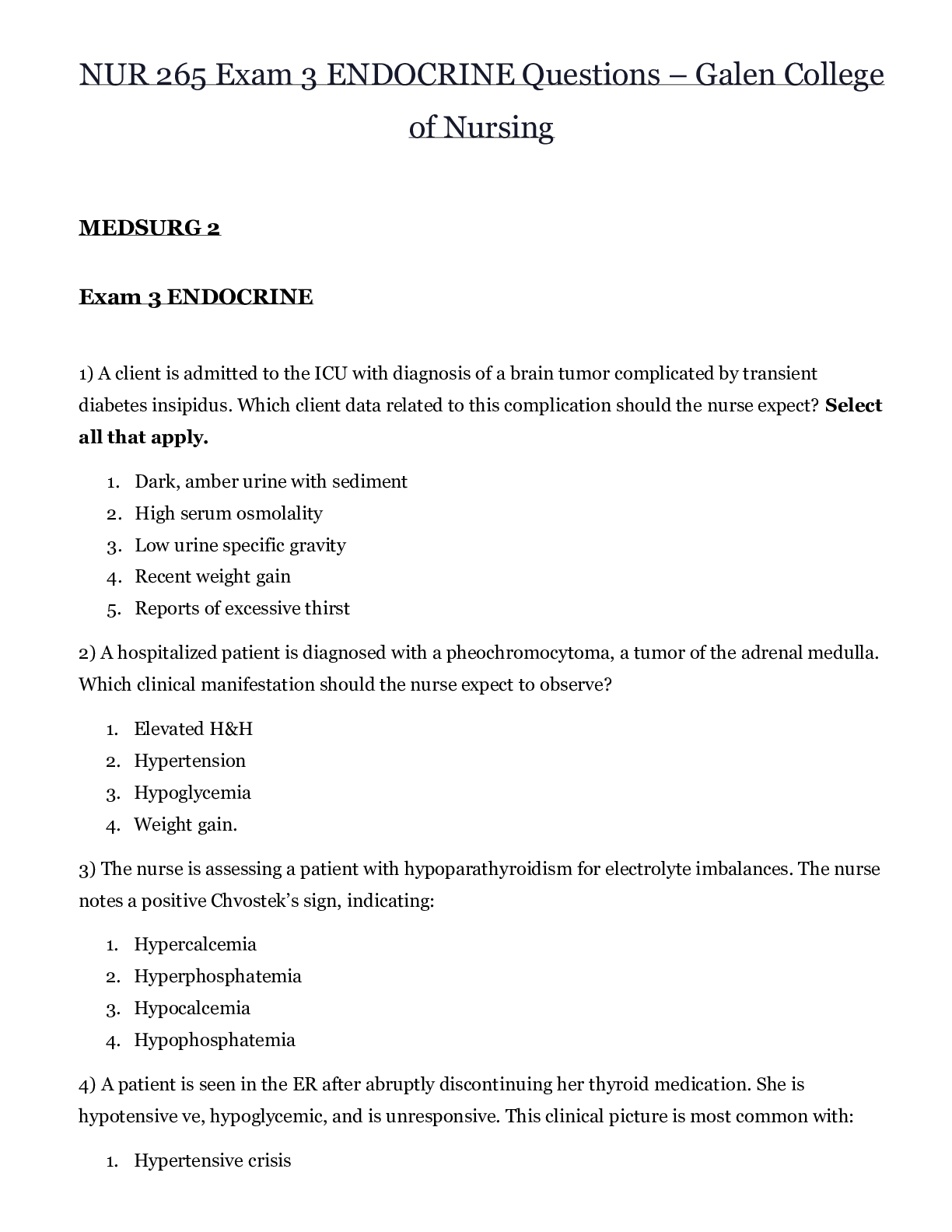
 – CHAMBERLAIN COLLEGE OF NURSING.png)
